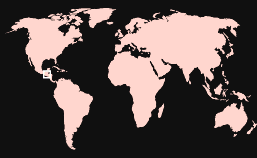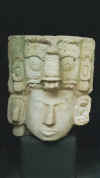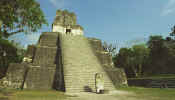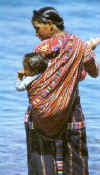Geography
 The
largest country in Central America, Guatemala has fertile Caribbean and Pacific
lowlands flanking the mountainous highlands which dominate the country.
The climate varies with altitude: tropical in the lowlands, temperate in
the highlands.
The
largest country in Central America, Guatemala has fertile Caribbean and Pacific
lowlands flanking the mountainous highlands which dominate the country.
The climate varies with altitude: tropical in the lowlands, temperate in
the highlands.
The environment is not a priority. Guatemala means 'land of
trees', but based on the degree of deforestation they should consider a
name change. Birdwatchers now have to go to Costa Rica to spot the
Resplendent Quetzal, Guatemala's national bird whose habitat has all but
disappeared.
History
 Pre-Colombian
Guatemala was dominated by the great Mayan civilization. The Maya were
once conceived of by scholars as star-gazing philosopher-kings, but recent
discoveries have shattered the conventional wisdom. The Maya loved a good
war, were keen on human sacrifice, and painted their temples blood red.
They also had some distinctive conceptions of personal beauty, going to
some lengths to flatten the foreheads and cross the eyes of their
children. Life for a Mayan king was no picnic, either; they were expected
to endure ritual bloodletting to appease the gods,
especially by piercing their own tongue and penis.
Pre-Colombian
Guatemala was dominated by the great Mayan civilization. The Maya were
once conceived of by scholars as star-gazing philosopher-kings, but recent
discoveries have shattered the conventional wisdom. The Maya loved a good
war, were keen on human sacrifice, and painted their temples blood red.
They also had some distinctive conceptions of personal beauty, going to
some lengths to flatten the foreheads and cross the eyes of their
children. Life for a Mayan king was no picnic, either; they were expected
to endure ritual bloodletting to appease the gods,
especially by piercing their own tongue and penis.
 Most of the great cities of the Maya were built during the
"Classic" period, from 250 to 900 AD. At this point major sites
such as Copan and Tikal were abandoned. This collapse is thought to have
been precipitated by migration, military campaigns and perhaps even popular
revolt, stemming ultimately from food shortages due to population pressure and
drought. Mayan civilization would yet undergo a 'Post-Classic'
renaissance to the north, in Yucatan.
Most of the great cities of the Maya were built during the
"Classic" period, from 250 to 900 AD. At this point major sites
such as Copan and Tikal were abandoned. This collapse is thought to have
been precipitated by migration, military campaigns and perhaps even popular
revolt, stemming ultimately from food shortages due to population pressure and
drought. Mayan civilization would yet undergo a 'Post-Classic'
renaissance to the north, in Yucatan.
Little was left of Mayan civilization when the Spanish arrived in 1524,
except of course the people. The Spanish promptly conquered them, took
their land, and put them to work as slaves. For the next 300 years,
Guatemala languished as a colonial backwater, gaining independence in
1821. Unfortunately, good government for all Guatemalans did not result, and the plight of the Maya
generally worsened. After a CIA-sponsored military coup overthrew a
democratically-elected government in 1954, violence became a staple of political
life. Between 1960 and 1996 civil war raged throughout Guatemala, during
which an estimated 200,000 people were killed, a million forced from their
homes, and uncounted thousands 'disappeared'. The overwhelming
majority of these victims were Maya. Guatemala today is ostensibly a
democratic republic at peace, but it is unclear whether civilian control of the
military, and equality for the Maya, are more than just theoretical.
good government for all Guatemalans did not result, and the plight of the Maya
generally worsened. After a CIA-sponsored military coup overthrew a
democratically-elected government in 1954, violence became a staple of political
life. Between 1960 and 1996 civil war raged throughout Guatemala, during
which an estimated 200,000 people were killed, a million forced from their
homes, and uncounted thousands 'disappeared'. The overwhelming
majority of these victims were Maya. Guatemala today is ostensibly a
democratic republic at peace, but it is unclear whether civilian control of the
military, and equality for the Maya, are more than just theoretical.
People
The population is 11 million, only 39% of whom reside in urban areas.
Approximately half of all Guatemalans are indigenous Indian, or Maya; they live
worlds apart from the ladinos who run the country. There are nearly
two dozen mutually unintelligible Mayan languages used today, which explains the
preeminence of Spanish outside of isolated rural areas. Roman Catholicism
is the dominant organized religion, although it is subordinate to traditional
practices in the countryside.
Guatemalans have been brutalized by centuries of ethnic conflict, culminating
in the decades-long civil war. Weapons are ubiquitous and the typical
Guatemalan looks on with indifference at the misfortune of others. Petty
theft and muggings are routine occurrences, rape and murder are not uncommon,
and the police are universally despised.
The UN ranks Guatemala in the 31st percentile in terms of quality of life, based
on life expectancy, education and income; this is at the bottom of the Latin American
heap, and in the Western Hemisphere worsted only by Haiti.
Economy
Guatemala is a middle-income economy, with a GNP per capita of $1,600 per year.
This figure hides dramatic wealth disparities: the incomes of the richest
20% are 30 times greater than the poorest 20%, the worst instance of income
inequality in Latin America.Agriculture is the key sector, including
coffee, sugar, bananas and beef. Guatemala is also the world's largest
producer of cardamom, most of which is exported to the Middle East for use in
coffee.
Tourism is important to parts of the country. There were 600,000
arrivals in 1998, most of them focused on Antigua and surrounding sights, and
the Mayan ruins at Tikal and Copan.
Sources: World Bank (1998 data), Dorling Kindersley
World Reference Atlas, UNDP Human Development Report, Lonely Planet